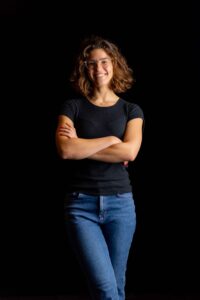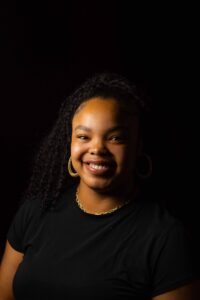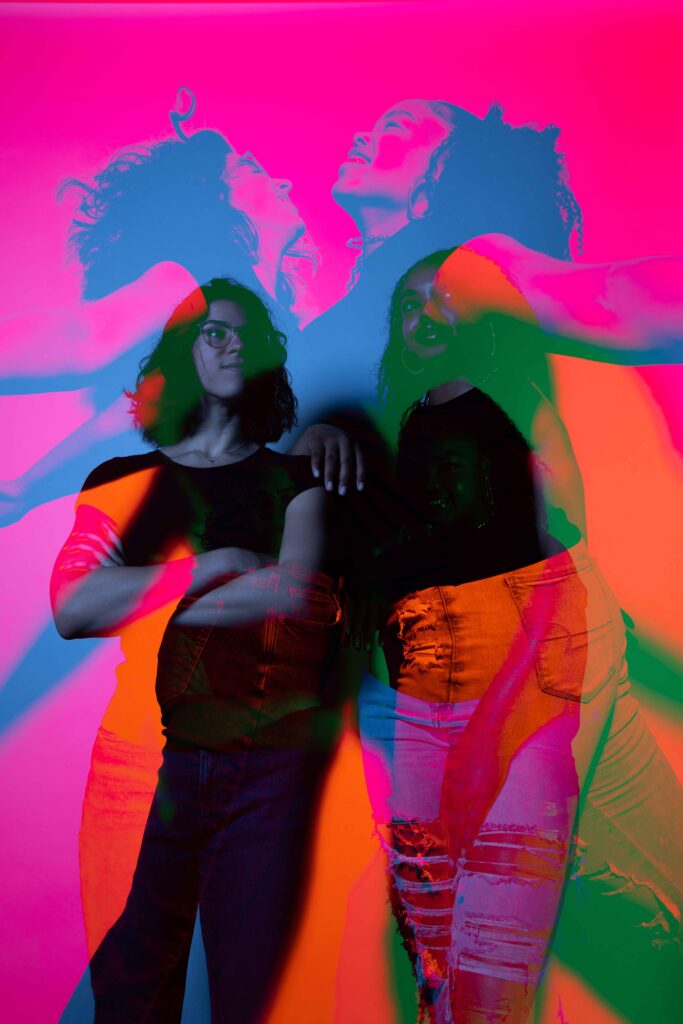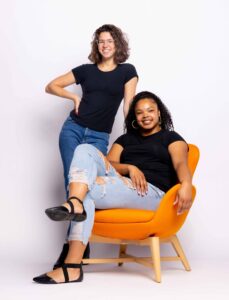Walking down Johnson-Ward Pedestrian Walkway on UT’s campus, a few times a year you can find a group of students telling passing pedestrians that it only takes five minutes to save a life.
The group is Project Life Movement, and its mission is to grow the number of potential bone marrow and stem cell donors on the global registry in order to help save lives and cure diseases such as leukemia, lymphoma, and sickle cell disease. It was started by students at Davidson College in North Carolina in 1990 and became a nonprofit in 2011.
Project Life Movement finds potential donors by setting up drives in high-traffic areas on college campuses and swabbing the cheeks of students who volunteer.

Lady Vol swimmer and architecture major Margaret Marando
Lady Vol swimmer Margaret Marando got her start with Project Life Movement in spring 2022 when looking for volunteer opportunities as part of the VOLeaders Academy, a UT program that teaches student-athletes leadership skills and how to create positive social change through sport.
She volunteered for an hour signing up donors on campus and had her own cheek swabbed. While the hour Marando spent volunteering was fulfilling, what came in the following months changed her life—and someone else’s.
“As a volunteer, the easiest way to learn is to swab your cheeks yourself and go through the process,” Marando says. “It takes five minutes, and so I did that.”
A few months after swabbing her cheek, Marando got several calls, a text, a letter, and messages on social media from Project Life Movement, which was urgently trying to get in touch with her.
Marando’s bone marrow was a match for a four-year-old boy with acute lymphoblastic leukemia—a type of cancer in the blood and bone that creates immature blood cells.
She says the gravity of what she had volunteered for when doing the cheek swab hadn’t really hit her until she got the call that she was a match.
It was a big decision for the swimmer—a Division 1 student-athlete competing on a scholarship. The procedure and recovery would take her out of competition for six weeks.
But the missed competition time meant nothing to Marando, knowing she could possibly save the life of a little boy. “Six weeks compared to the rest of his life is minuscule,” Marando says.
And the decision was made easier with support from her coaches and teammates. She recalls a conversation with Associate Head Coach Ashley Jahn. “I vividly remember she said, ‘Margaret, there’s swimming, and then there’s life, and this is life. And we support you 100 percent,’” Marando says.

Lady Vol swimmer and architecture major Margaret Marando
“She had texted the coaches, and they all were on board. My entire team was super supportive.”
When having those conversations about the process and how it would impact her swimming, Marando’s coaches saw something revealing about her character.
“It allowed her to have an impact on somebody who is outside of her normal orbit, and she jumped at the chance,” Director of Swimming and Diving Matt Kredich says. “I think that tells you who she is. She’s just an incredibly giving person.”
The donation procedure is not an easy one. Following a battery of tests and bloodwork, the donor is placed under anesthesia and hollow needles are inserted through the skin into the back of the pelvic bone to draw out the marrow. The process can take up to two hours, according to the Mayo Clinic.
Even through the painful process, Marando never seemed to be hesitant of her decision.
“There was never any sign still that she viewed the ordeal as something other than just a great opportunity,” Kredich says.
“Weeks of recovery and weeks of pain and discomfort—that never seemed to bother her. It was just really inspiring for all of us on the team.”
Marando’s bone marrow was shipped to the boy with leukemia within 24 hours of extraction and transplanted in the hopes that the donated marrow would help his body begin to produce healthy blood cells.
The boy is recovering, and Marando hopes to have the opportunity to meet him one day.
The same Volunteer spirit that led Marando to donate bone marrow led to her major in architecture and her goal of serving the African country of Rwanda through education about efficient and sustainable design.
“I chose to do this major almost for the exact reason I chose to donate bone marrow—to better the lives of those around me,” Marando says. “The built environment has such an impact on our lives and the world around us.”
Putting Others before Yourself

Former Lady Vol basketball player and current PhD student Keyen Green
Marando is one of several student-athletes who have volunteered with Project Life Movement at UT. Keyen Green, a former Lady Vol basketball player and current PhD student, got her start with the nonprofit in 2020 while playing basketball at Liberty University.
A few of Green’s teammates were working with a Project Life Movement drive on campus, and Green went to support them.
After getting swabbed she didn’t think about it again until about a year later, when she, like Marando, got the call.
Green was back home in Florida in spring 2020, early in the COVID-19 pandemic, when she received several calls from an unknown number. It was Project Life Movement telling her she was a match and asking her to donate stem cells.
“I don’t like to say a fluke, because everything is for a reason,” Green says.
The timing couldn’t have been more perfect. With basketball on hold due to the pandemic, Green had no external factors keeping her from donating her stem cells.

Keyen Green
“I honestly don’t know if my coach [at Liberty] would’ve let me leave to go donate, but it was the perfect opportunity,” Green says.
Green spent time in discussion with her family before deciding to donate. Ultimately, she agreed to go through with it because the process was made so easy by Project Life Movement.
Green was in the recruiting process with Lady Vols Head Coach Kellie Harper when she made her decision to donate stem cells. She and Harper discussed the decision and possible outcomes.
“To just be a random person and still be able to contribute in that way, to help someone in that situation? It still blows my mind, it really does,” Green said in a March 2022 story in The Athletic. “And I just feel blessed that I was chosen. It’s really humbling to me what the Lord has planned for my life.”
Getting involved with Project Life Movement had some unexpected benefits, too. Before she got involved, Green had a small circle of friends, mostly in athletics. Now she has forged relationships outside of athletics through connections made with Project Life Movement.
“Just being able to be me and develop those relationships in a different sphere than athletics has been so rewarding,” she says.
Now Marando and Green are both advocates for Project Life Movement.
Marando has convinced many of her teammates and other UT student-athletes to participate in a cheek swab, reminding them how easy the process is.

Margaret Marando and Keyen Green
“I am really grateful that I’ve been given the opportunity to share this story and tell other people how easy and simple it is to save a life,” Marando says. “Because it really does take five minutes.”
After Green came to campus, she led a Project Life Movement drive that gathered 376 donors, according to the story in The Athletic.
As Green finishes up her PhD in educational leadership at UT, researching why Black women are underrepresented in higher education administration, she looks forward to maintaining a relationship with Project Life Movement.
“Now that I’m about to finish school at Tennessee, I’m excited to see how it will progress going forward, how we can still maintain a connection,” Green says. “Whether that’s me coming back to campus to do drives or doing them other places, I’m excited to see what that transition will look like.”
For Marando, working with Project Life Movement and going through the process of donating bone marrow is just part of being a Volunteer. Both women committed even further to that mindset when they enrolled at UT.

Margaret Marando (standing) and Keyen Green
“We are the Volunteers. That’s why I came to this school,” Marando says. “I loved that. I loved that idea. I love that mantra. And I was able to really live that out with this experience.”
And though she wasn’t a Vol at the time, that mindset was already engrained in Green when she decided to donate. Now she encourages other students to remember what makes them Volunteers.
“To be a Volunteer—I think it just means putting others’ needs before yourself,” Green says. “To be someone that would never ask someone to do something that you wouldn’t be willing to do yourself. I think that spans every area of life, and it’s really about not focusing on yourself.”


2 comments
Thank you for this incredible story of courage and faith.
Bless you Margaret Morando for donating. 🙏🏻🧡🙏🏻 I know this little boy’s Mother, I have followed his story since he was 2 1/2 yrs old. The world needs more people like you. ❤️
Comments are closed.